Spatial Differentiation and Environmental Controls of Land Consolidation Effectiveness: A Remote Sensing-Based Study in Sichuan, China
Abstract
:1. Introduction
2. Materials and Methods
2.1. Study Area
2.2. Sources of Data
2.2.1. LC Project Data
2.2.2. Sentinel-2 A/B and Landsat 8
2.2.3. Geospatial Data
2.3. Research Methods
2.3.1. Remote Sensing Data Processing and CumVI Calculation
2.3.2. Characteristic Parameter Method to Identify Production Capacity Changes
2.3.3. Research on the Spatial Distribution of LC Effectiveness
2.3.4. Quantitative Attribution of Natural Factors for LC Effectiveness
3. Results
3.1. Typical Processes and Characteristics of LC Effectiveness
3.2. Spatial Distribution of LC Effectiveness
3.3. Natural Attribution of LC Effectiveness Based on GeoDetector
3.4. Natural Attribution of LC Effectiveness Based on GWR
4. Discussions
4.1. Advantages and Advancements
4.2. The Impact and Inspiration of LC on Farmland Productivity
4.3. Limitations and Future Work
5. Conclusions
Author Contributions
Funding
Data Availability Statement
Conflicts of Interest
References
- Van Dijk, M.; Morley, T.; Rau, M.L.; Saghai, Y. A meta-analysis of projected global food demand and population at risk of hunger for the period 2010–2050. Nat. Food 2021, 2, 494–501. [Google Scholar] [CrossRef] [PubMed]
- Song, X.; Ouyang, Z. Key Influencing Factors of Food Security Guarantee in China during 1999–2007. Acta Geogr. Sin. 2012, 67, 793–803. [Google Scholar] [CrossRef]
- Fu, Z.; Cai, Y.; Yang, Y.; Dai, E. Research on the relationship of cultivated land change and food security in China. J. Nat. Resour. 2001, 16, 313–319. [Google Scholar] [CrossRef]
- Potapov, P.; Turubanova, S.; Hansen, M.C.; Tyukavina, A.; Zalles, V.; Khan, A.; Song, X.P.; Pickens, A.; Shen, Q.; Cortez, J. Global maps of cropland extent and change show accelerated cropland expansion in the twenty-first century. Nat. Food 2022, 3, 19–28. [Google Scholar] [CrossRef] [PubMed]
- Xu, X.; Chen, Q.; Zhu, Z. Evolutionary Overview of Land Consolidation Based on Bibliometric Analysis in Web of Science from 2000 to 2020. Int. J. Environ. Res. Public Health 2022, 19, 3218. [Google Scholar] [CrossRef] [PubMed]
- Zhu, D.; Lu, Y.; Liu, L. Land Development & Consolidation and Quality Management of Cultivated Land. Trans. Chin. Soc. Agric. Eng. 2002, 18, 167–171. [Google Scholar]
- Zhang, H. Provincial scale spatial variation of cultivated land production capacity and its impact factors. Trans. Chin. Soc. Agric. Eng. 2010, 26, 308–314. [Google Scholar]
- Long, H.; Zhang, Y.; Tu, S. Rural vitalization in China: A perspective of land consolidation. J. Geogr. Sci. 2019, 29, 517–530. [Google Scholar] [CrossRef]
- Jiang, Y. Land consolidation and rural vitalization: A perspective of land use multifunctionality. Prog. Geogr. 2021, 40, 487–497. [Google Scholar] [CrossRef]
- Li, S.; Song, W. Research Progress in Land Consolidation and Rural Revitalization: Current Status, Characteristics, Regional Differences, and Evolution Laws. Land 2023, 12, 210. [Google Scholar] [CrossRef]
- Wan, T.; Liu, J.; Tan, Z.; Huang, D. Practice of land consolidation in Germany and its implication to the integrated planning and utilization of collective-owned constructible lands in rural China. City Plan. Rev. 2018, 42, 54–61. [Google Scholar]
- Du, J.; Sun, P. Review on Land Consolidation Research. J. Shanxi Agric. Sci. 2010, 38, 83–87. [Google Scholar]
- Lu, D.; Wang, Z.; Su, K.; Zhou, Y.; Li, X.; Lin, A. Understanding the impact of cultivated land-use changes on China’s grain production potential and policy implications: A perspective of non-agriculturalization, non-grainization, and marginalization. J. Clean. Prod. 2024, 436, 140647. [Google Scholar] [CrossRef]
- Zhao, Q.; Zhou, S.; Wu, S.; Ren, K. Cultivated land resources and strategies for its sustainable utilization and protection in China. Acta Pedol. Sin. 2006, 43, 662–672. [Google Scholar]
- Lv, X.; Xiao, W.; Li, S.; Wang, Q.; Zhang, C.; Zhang, M. Land reclamation zoning of Chaohu Lake Basin based on GIS and grey constellation clustering. Trans. Chin. Soc. Agric. Eng. 2018, 34, 253–262. [Google Scholar]
- Luo, M.; Wang, J. A study on regional differences of land consolidation in China and suggestions. Prog. Geogr. 2001, 20, 97–103. [Google Scholar] [CrossRef]
- Xin, G.; Yang, C.; Yang, Q.; Li, C.; Wei, C. Post-evaluation of well-facilitied capital farmland construction based on entropy weight method and improved TOPSIS model. Trans. Chin. Soc. Agric. Eng. 2017, 33, 238–249. [Google Scholar]
- Xu, K.; Jin, X.; Wu, D.; Zhou, Y. Cultivated land quality evaluation of land consolidation project based on agricultural land gradation. Trans. Chin. Soc. Agric. Eng. 2015, 31, 247–255. [Google Scholar]
- Tang, X.; Pan, Y.; Liu, Y.; Ren, Y. Calculation method of cultivated land consolidation potential based on cultivated land coefficient and pre-evaluation of farmland classification. Trans. Chin. Soc. Agric. Eng. 2014, 30, 211–218. [Google Scholar]
- Xu, S.; Xiao, W.; Yu, C.; Chen, H.; Tan, Y. Mapping Cropland Abandonment in Mountainous Areas in China Using the Google Earth Engine Platform. Remote Sens. 2023, 15, 1145. [Google Scholar] [CrossRef]
- Xiao, W.; Xu, S.; He, T. Mapping Paddy Rice with Sentinel-1/2 and Phenology-, Object-Based Algorithm—A Implementation in Hangjiahu Plain in China Using GEE Platform. Remote Sens. 2021, 13, 990. [Google Scholar] [CrossRef]
- He, T.; Guo, J.; Xiao, W.; Xu, S.; Chen, H. A novel method for identification of disturbance from surface coal mining using all available Landsat data in the GEE platform. ISPRS J. Photogramm. Remote Sens. 2023, 205, 17–33. [Google Scholar] [CrossRef]
- Atzberger, C. Advances in Remote Sensing of Agriculture: Context Description, Existing Operational Monitoring Systems and Major Information Needs. Remote Sens. 2013, 5, 4124. [Google Scholar] [CrossRef]
- Dai, E.; Li, S.; Wu, Z.; Yan, H.; Zhao, D. Spatial pattern of net primary productivity and its relationship with climatic factors in Hilly Red Soil Region of southern China: A case study in Taihe county, Jiangxi province. Geogr. Res. 2015, 34, 1222–1234. [Google Scholar] [CrossRef]
- Paul, C.; Sophie, M.; Paul, W.; Alan, S. Crop Yield Assessment from Remote Sensing. Photogramm. Eng. Remote Sens. 2003, 69, 665–674. [Google Scholar]
- Fan, Y.; Jin, X.; Xiang, X.; Yang, X.; Huang, X.; Zhou, Y. Prediction and evaluation of characteristic of agricultural productivity change influenced by farmland consolidation: Method and case study. Geogr. Res. 2016, 35, 1935–1947. [Google Scholar] [CrossRef]
- Du, X.; Zhang, X.; Jin, X. Assessing the effectiveness of land consolidation for improving agricultural productivity in China. Land Use Policy 2018, 70, 360–367. [Google Scholar] [CrossRef]
- Hong, C.; Jin, X.; Ren, J.; Gu, Z.; Zhou, Y. Satellite data indicates multidimensional variation of agricultural production in land consolidation area. Sci. Total Environ. 2019, 653, 735–747. [Google Scholar] [CrossRef] [PubMed]
- Zhang, J.; Dong, Y.; Ye, Z. Calculation of county-level cultivated land productivity based on NPP index corrected by topography. Trans. Chin. Soc. Agric. Eng. 2020, 36, 227–234. [Google Scholar]
- Huang, C.; Zhang, J.; Yang, W.; Tang, X.; Zhao, A. Dynamics on forest carbon stock in Sichuan Province and Chonqing City. Acta Ecol. Sin. 2008, 2008, 966–975. [Google Scholar]
- Zhang, K.; Roy, D.P.; Yan, L.; Li, Z.; Huang, H.; Vermote, E.; Skakun, S.; Roger, J. Characterization of Sentinel-2A and Landsat-8 top of atmosphere, surface, and nadir BRDF adjusted reflectance and NDVI differences. Remote Sens. Environ. 2018, 215, 482–494. [Google Scholar] [CrossRef]
- Johnson, M. An assessment of pre- and within-season remotely sensed variables for forecasting corn and soybean yields in the United States. Remote Sens. Environ. 2014, 141, 116–128. [Google Scholar] [CrossRef]
- Chen, Y.; Han, B.; Jin, X.; Zhang, Y. Analysis of the cropland productivity change and the impact of land consolidation in the Yangtze River Economic Zone. Trans. Chin. Soc. Agric. Eng. 2023, 39, 182–193. [Google Scholar]
- Huang, H.; Wu, C.; Zhang, S. Benefits analysis and evaluation on land consolidation planning in Heilongjiang province. Trans. Chin. Soc. Agric. Eng. 2012, 28, 240–246. [Google Scholar]
- Chen, W.; Liu, L.; Liang, Y. Retail center recognition and spatial aggregating feature analysis of retail formats in Guangzhou based on POI data. Geogr. Res. 2016, 35, 703–716. [Google Scholar] [CrossRef]
- Wang, J.; Xu, C. Geodetector: Principle and perspective. Acta Geogr. Sin. 2017, 72, 116–134. [Google Scholar]
- Wang, J.; Hu, Y. Environmental health risk detection with GeogDetector. Environ. Model. Softw. 2012, 33, 114–115. [Google Scholar] [CrossRef]
- Cao, X.; Xu, J. Spatial heterogeneity analysis of regional economic development and driving factors in China’s provincial border counties. Acta Geogr. Sin. 2018, 73, 1065–1075. [Google Scholar] [CrossRef]
- Lu, B.; Ge, Y.; Qin, K.; Zheng, J. A Review on Geographically Weighted Regression. Geomat. Inf. Sci. Wuhan Univ. 2020, 45, 1356–1366. [Google Scholar]
- Waqas, M.A.; Li, Y.; Smith, P.; Wang, X.; Ashraf, M.N.; Noor, M.A.; Amou, M.; Shi, S.; Zhu, Y.; Li, J.; et al. The influence of nutrient management on soil organic carbon storage, crop production, and yield stability varies under different climates. J. Clean. Prod. 2020, 268, 121922. [Google Scholar] [CrossRef]
- Qiu, J.; Wang, L.; Li, H.; Tang, H.; Li, C.; Van Ranst, E. Modeling the Impacts of Soil Organic Carbon Content of Croplands on Crop Yields in China. Sci. Agric. Sin. 2009, 42, 154–161. [Google Scholar] [CrossRef]
- Shu, J.; Bai, Y.; Chen, Q.; Weng, C.; Zhang, F. Dynamic simulation of the water-land-food nexus for the sustainable agricultural development in the North China Plain. Sci. Total Environ. 2023, 912, 168771. [Google Scholar] [CrossRef] [PubMed]
- Guo, A.; Yue, W.; Yang, J.; Xue, B.; Xiao, W.; Li, M.; He, T.; Zhang, M.; Jin, X.; Zhou, Q. Cropland abandonment in China: Patterns, drivers, and implications for food security. J. Clean. Prod. 2023, 418, 138154. [Google Scholar] [CrossRef]
- Spyridon, P.; Attoh, E.M.N.A.N.; Sutanto, S.J.; Snoeren, N.; Ludwig, F. Local rainfall forecast knowledge across the globe used for agricultural decision-making. Sci. Total Environ. 2023, 899, 165539. [Google Scholar] [CrossRef]
- Ma, Y.; Woolf, D.; Fan, M.; Qiao, L.; Li, R.; Lehmann, J. Global crop production increase by soil organic carbon. Nat. Geosci. 2023, 16, 1159–1165. [Google Scholar] [CrossRef]
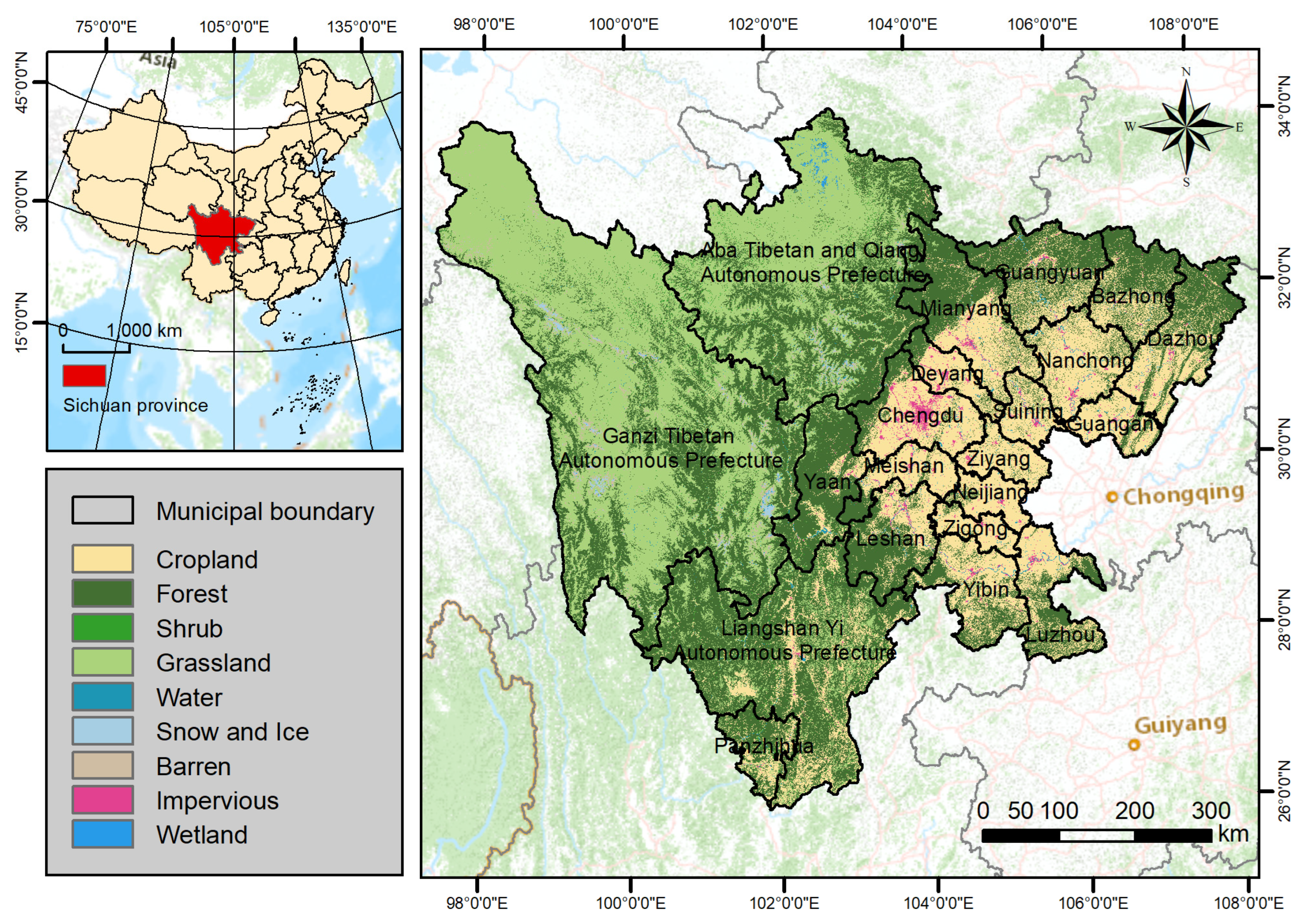
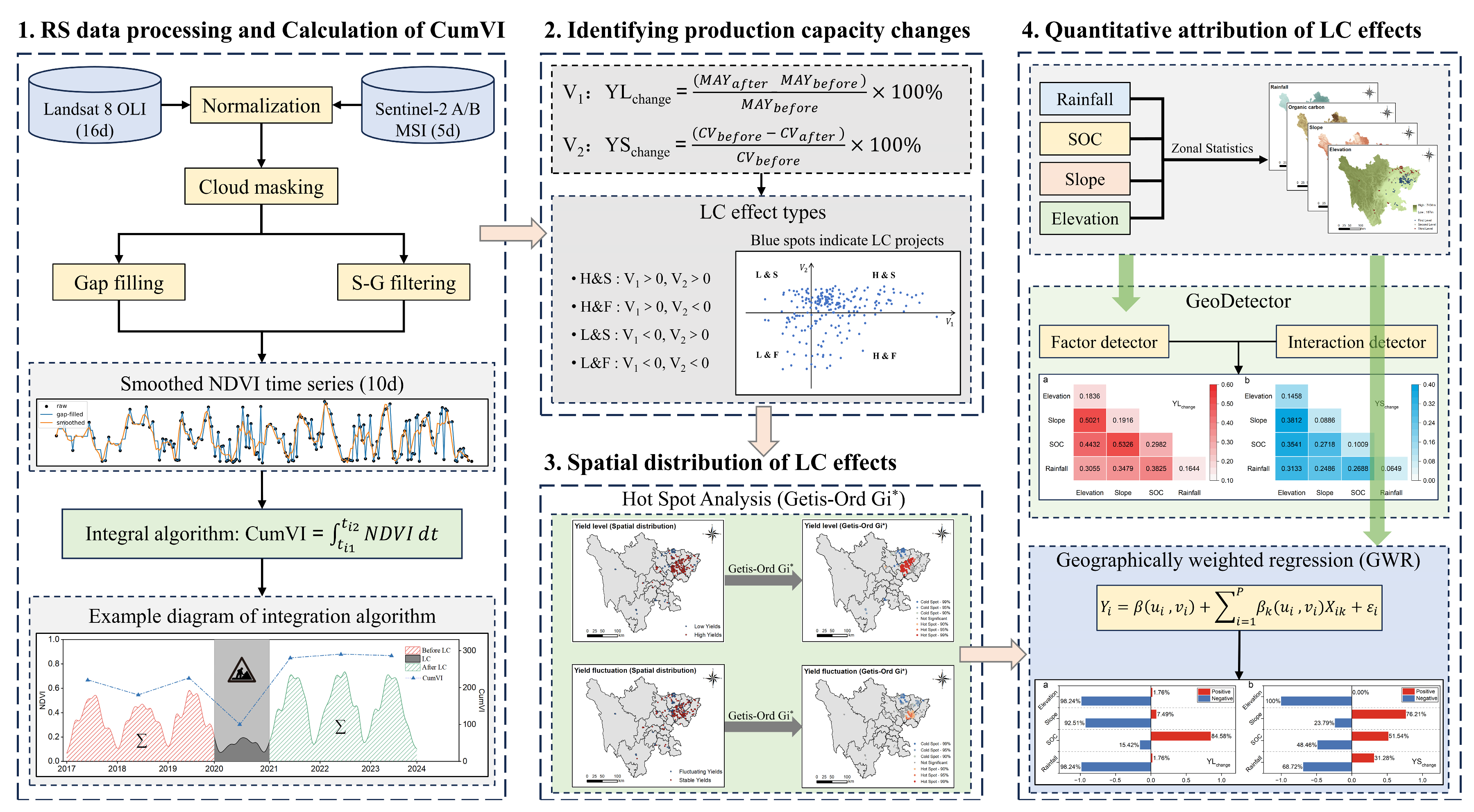

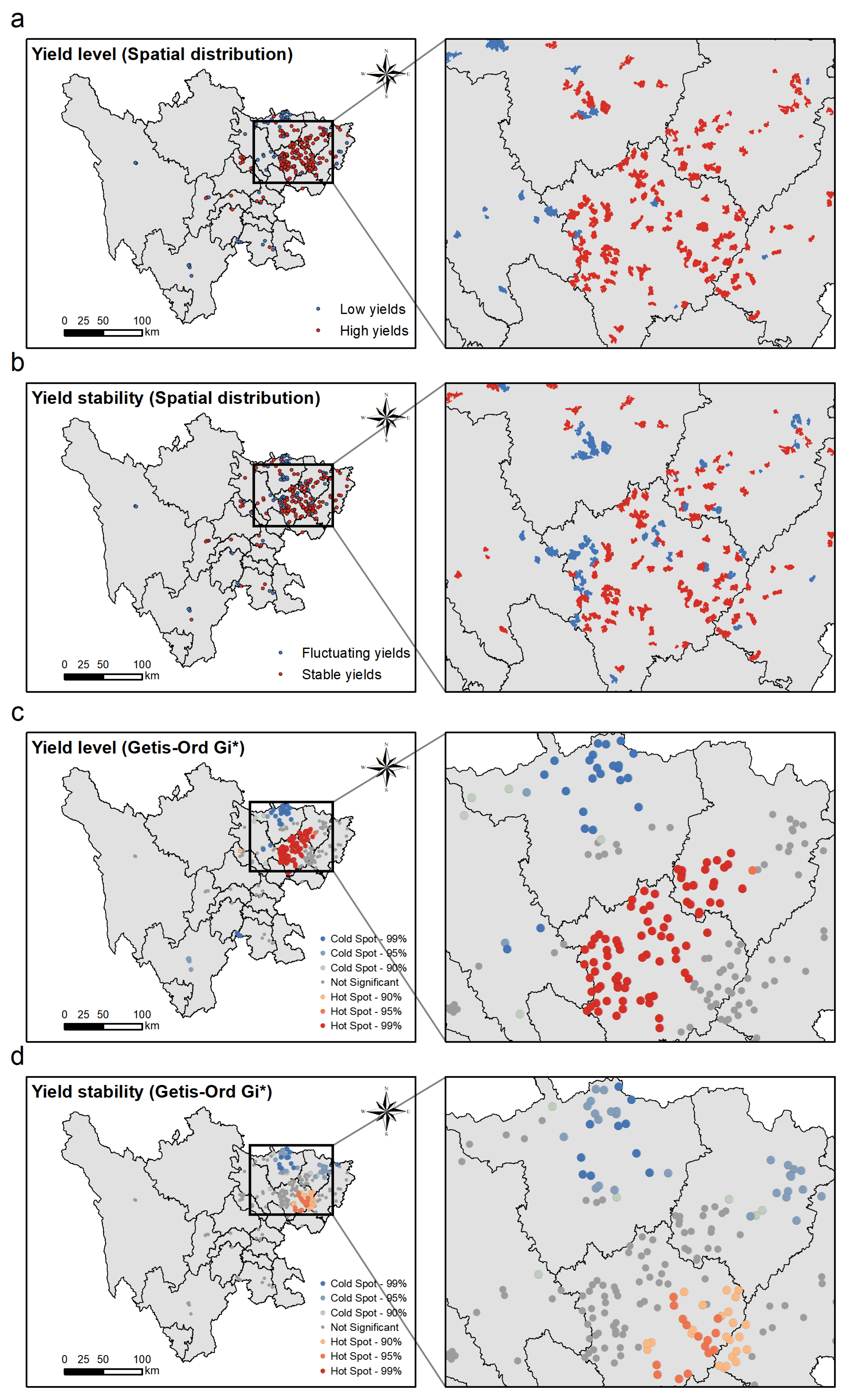


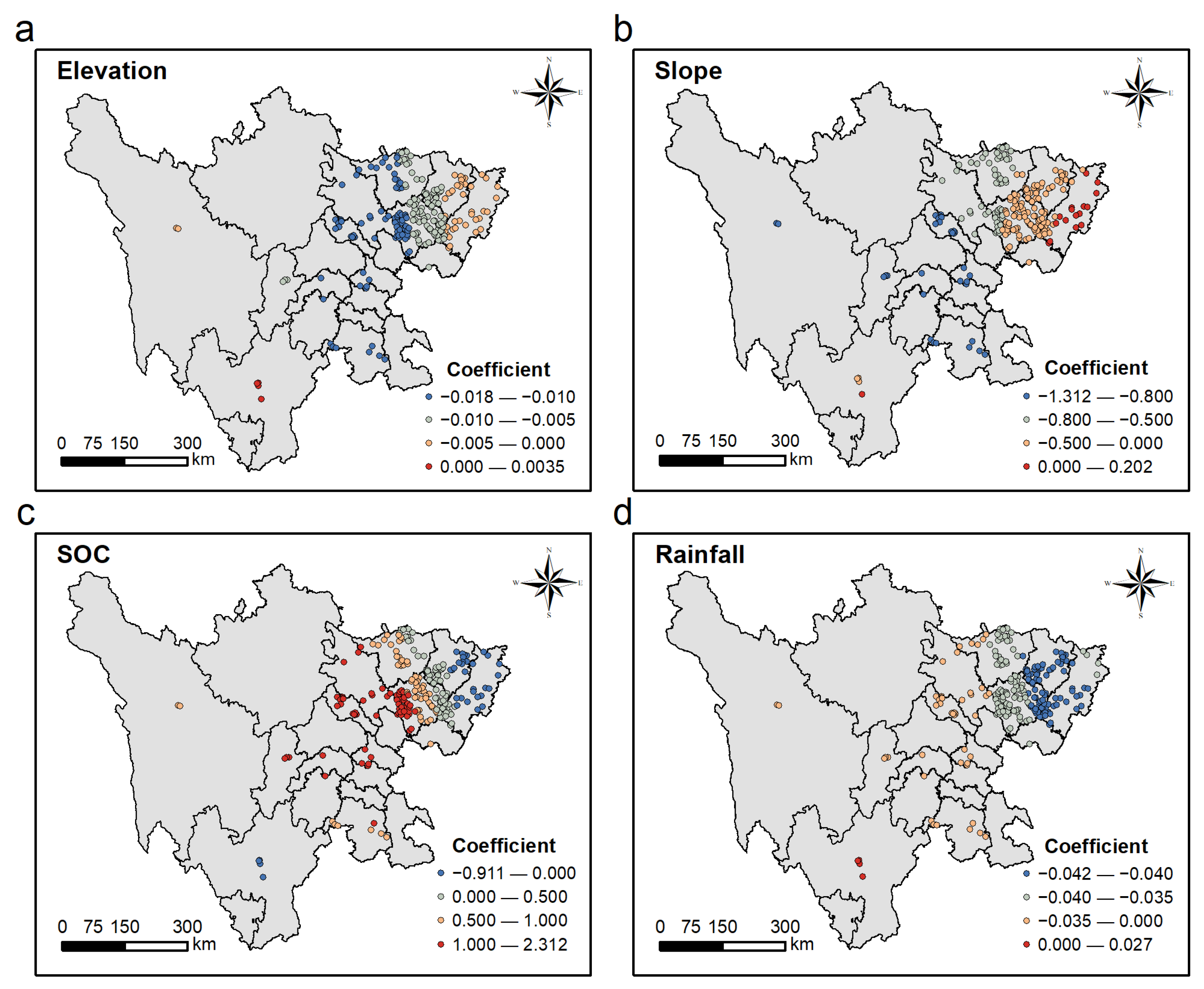
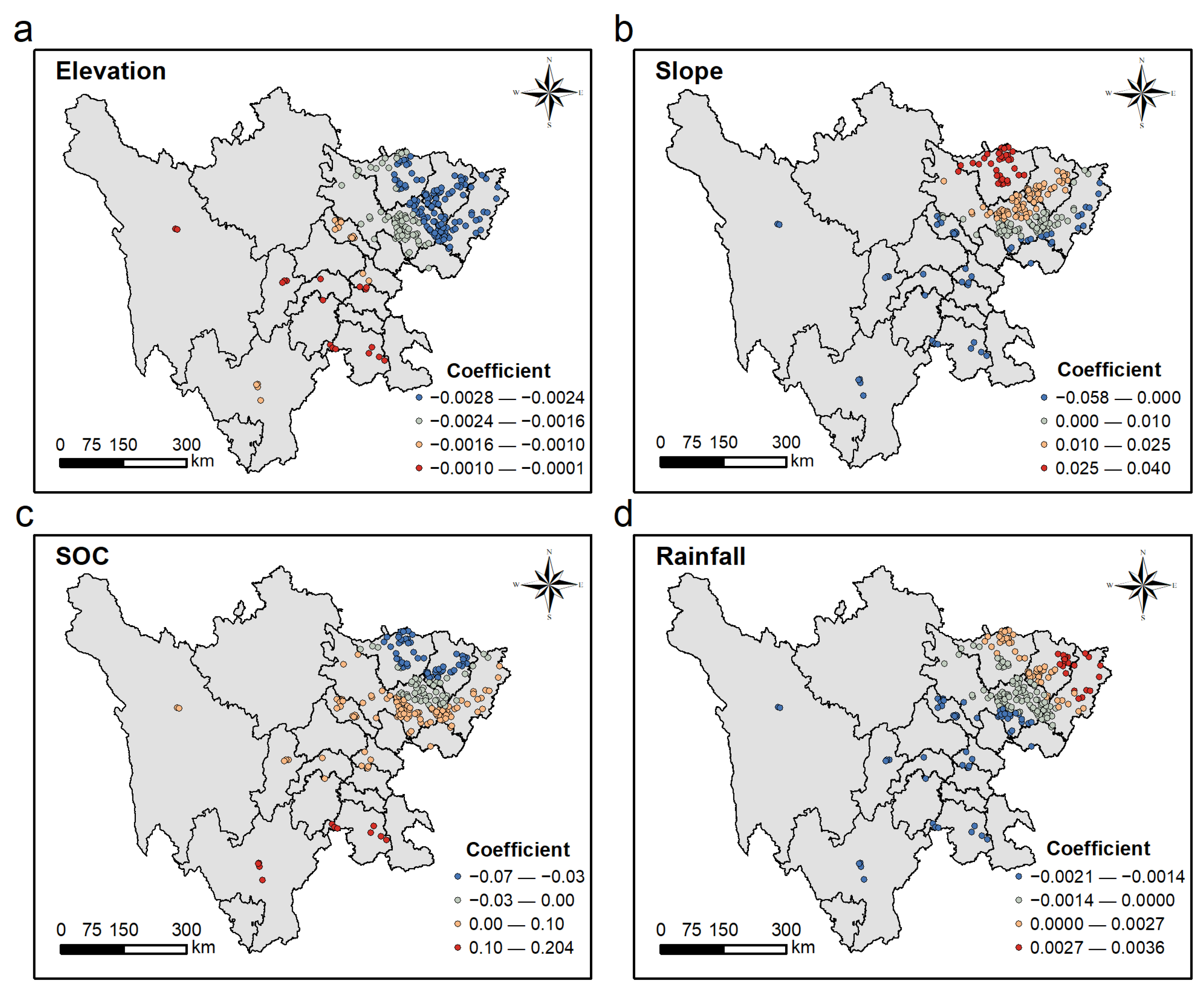
| Data | Classification | Resolution | Time | Data source |
|---|---|---|---|---|
| Landsat 8 | raster | 30 m | 2017–2024 | https://www.usgs.gov (accessed on 12 December 2023) |
| Sentinel-2 | raster | 10 m | 2017–2024 | https://www.esa.int (accessed on 12 December 2023) |
| LC project | vector | / | 2020 | Sichuan Provincial Government (accessed on 5 March 2022) |
| DEM | raster | 30 m | 2022 | https://panda.copernicus.eu/panda (accessed on 3 January 2024) |
| SOC | raster | 250 m | 1950–2017 | https://data.isric.org/geonetwork (accessed on 3 January 2024) |
| Rainfall | raster | 1 km | 2020 | https://www.gis5g.com (accessed on 3 January 2024) |
| H and S | H and F | L and S | L and F | |
|---|---|---|---|---|
| Full name | High and stable yield | High and fluctuating yield | Low and stable yield | Low and fluctuating yield |
| Index | V1 > 0, V2 > 0 | V1 > 0, V2 < 0 | V1 < 0, V2 > 0 | V1 < 0, V2 < 0 |
| YLchange | YSchange | |||||
|---|---|---|---|---|---|---|
| Factors | q | p | q | p | ||
| Elevation | 0.1836 | 0.000 | 3 | 0.1458 | 0.011 | 1 |
| Slope | 0.1916 | 0.000 | 2 | 0.0886 | 0.000 | 3 |
| SOC | 0.2982 | 0.000 | 1 | 0.1009 | 0.007 | 2 |
| Rainfall | 0.1644 | 0.000 | 4 | 0.0649 | 0.048 | 4 |
| YLchange | YSchange | |||||
|---|---|---|---|---|---|---|
| Model | R2 | Adj.R2 | AICc | R2 | Adj.R2 | AICc |
| OLS | 0.514 | 0.505 | 167.42 | 0.205 | 0.191 | 257.76 |
| GWR | 0.886 | 0.843 | 85.76 | 0.661 | 0.554 | 101.69 |
Disclaimer/Publisher’s Note: The statements, opinions and data contained in all publications are solely those of the individual author(s) and contributor(s) and not of MDPI and/or the editor(s). MDPI and/or the editor(s) disclaim responsibility for any injury to people or property resulting from any ideas, methods, instructions or products referred to in the content. |
© 2024 by the authors. Licensee MDPI, Basel, Switzerland. This article is an open access article distributed under the terms and conditions of the Creative Commons Attribution (CC BY) license (https://creativecommons.org/licenses/by/4.0/).
Share and Cite
Bao, J.; Xu, S.; Xiao, W.; Wu, J.; Tang, T.; Zhang, H. Spatial Differentiation and Environmental Controls of Land Consolidation Effectiveness: A Remote Sensing-Based Study in Sichuan, China. Land 2024, 13, 990. https://doi.org/10.3390/land13070990
Bao J, Xu S, Xiao W, Wu J, Tang T, Zhang H. Spatial Differentiation and Environmental Controls of Land Consolidation Effectiveness: A Remote Sensing-Based Study in Sichuan, China. Land. 2024; 13(7):990. https://doi.org/10.3390/land13070990
Chicago/Turabian StyleBao, Jinhao, Sucheng Xu, Wu Xiao, Jiang Wu, Tie Tang, and Heyu Zhang. 2024. "Spatial Differentiation and Environmental Controls of Land Consolidation Effectiveness: A Remote Sensing-Based Study in Sichuan, China" Land 13, no. 7: 990. https://doi.org/10.3390/land13070990







